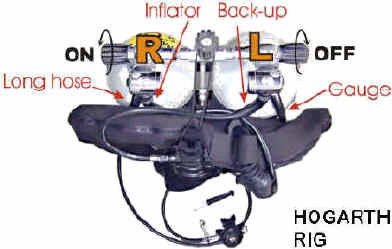Why The Right? | Technical Cave Diving Basics | Matt London
Cave Diving Basics – by Matt London
Here is a brief outline of the Hogarth / DIR regulator hose configuration method for back-mounted doubles that I use. If you are planning on participating in technical cave diving, tech or overhead diver training curriculums then you should definitely familiarize yourself with this material. The following are the most FAQ’s of hose valve configuration.

Why the long hose primary regulator on the right post?
The long hose or primary breathing regulator is always on the right post in cave diving. The primary reason for the “long hose on right post” rule is that the left post on the double tank manifold can actually “roll off” or be turned or rotated to the “off” position, if accidentally bumped or rubbed against the cave ceiling, causing an interruption in breathing gas delivery. The right post on the other hand will tend to “roll-on” or into the “on” position if accidentally bumped or rubbed against something. The idea being that in the unlikely event that you should experience a left valve “roll off” during an air share emergency your buddy, the stressed diver in need (now with the long hose regulator from right post), is assured of an uninterrupted breathing gas supply during exit. The donating diver is in a much better position to reach the left valve located on his/her back in case of roll off.
Why does the BC inflator supply hose on the right post?
If in the same air sharing scenario as above you managed to smash into the cave ceiling with enough force that your left valve “rolls off” and “breaks off” (out of order) the BC inflator can be used as the third “manual” backup regulator. By depressing the inflator and deflator simultaneously you can draw a breath of air. It’s almost like having two regulators now coming off the right post (one old style “manual” and one “on-demand”) so you can continue donating air from your long hose while you are breathing off the BC inflator. But seriously in an all out emergency this could save you and your buddies life’s. THE BONUS: because you’re constantly adjusting buoyancy during the dive, you are in effect, continuously testing your second “manual” backup regulator.
Another good reason for installing the BC inflator hose on the right valve post is so that you never loose buoyancy in the event of a left valve “roll-off”. The alternate rationale for placing the inflator hose on the left post is to provide an alert of an accidental left post turn off. The problem is that you are likely to discover this situation when you go to inflate during a loss of buoyancy which could cause you to crash into something like a silty cave floor before you can get the left post turned back on again. That could put you and the dive team in an uncompromising or even dangerous situation.
Why the pressure gauge on the left valve post?
While on the topic of the Hogarthian cave diving double tank hose configuration the HP gauge is also connected to the left valve post because mounting the gauge in this fashion assures recognition of accidental left valve “roll-off”. Example: If your HP gauge is not registering gas consumption you should check the left valve for a “roll off” before assuming that your pressure gauge is faulty or that you are breathing like a bird.
Why the back-up regulator on the left post?
Just one more time, because in an out of air (OOA) exit the donating diver is in a much better position to easily manipulate the valves supplying gas to both divers. If you are breathing from your back-up regulator, mounted to the left post, like you should then in the unlikely event you experience a roll-off you simply reach back and open the valve.;-))

